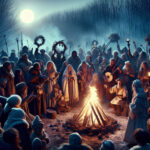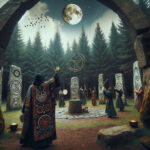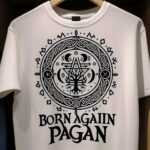Mother’s Day is a special holiday that we celebrate every year to honor mothers and recognize the important role they play in our lives. But did you know that Mother’s Day has a pagan origin? This article will explore the pagan roots of this beloved holiday and how it has evolved over the centuries. We will look at the various cultures and religions that have influenced the modern celebration of Mother’s Day and how it has become a cherished tradition for many around the world.

Mother’s Day is a holiday celebrated annually in many countries around the world. While it has become a secular holiday in the modern era, its roots can be traced back to ancient pagan rituals. This article will explore the pagan origins of Mother’s Day and how it has evolved into the celebration we know today.
Pre-Christian Pagan Rituals
Ancient pagan cultures celebrated the spring season with festivals of fertility and motherhood. In many cultures, there was a strong emphasis on honoring mother goddesses such as Gaia, Rhea, and Cybele. These goddesses were seen as the source of fertility, abundance, and protection.
In ancient Greece, Rhea was celebrated on the fourth day of the month Anthesterion, which is believed to have taken place in early Spring. Rhea was honored with a festival that included sacrifices, offerings, and processions.
In ancient Rome, Cybele was honored with a festival known as the “Hilaria” that took place in late March or early April. This festival celebrated the resurrection of Attis, a vegetation god, who was believed to be the son of Cybele. During this festival, a wooden pole was planted in the ground and decorated with ribbons and flowers.
Christian Influence on Mother’s Day
The modern celebration of Mother’s Day has its roots in the Christian tradition. During the 16th century, Christians in Europe began to celebrate the Feast of the Annunciation on March 25th. This feast commemorates the announcement by the angel Gabriel to the Virgin Mary that she would bear the son of God.
During the 17th century, this feast day was combined with the pagan rituals of honoring motherhood and fertility. This new celebration was known as “Mothering Sunday” and it was celebrated on the fourth Sunday of Lent. On this day, children would bring gifts to their mothers and offer them special treats.
Modern Mother’s Day
In the United States, Mother’s Day was first celebrated in 1908. Anna Jarvis, a West Virginia woman, campaigned for the holiday to be recognized as an official day of recognition for mothers. In 1914, President Woodrow Wilson declared the second Sunday in May as an official Mother’s Day holiday.
Today, Mother’s Day is celebrated in many countries around the world. While the holiday has become increasingly secularized, it still retains many of its pagan origins. Many people still honor their mothers by giving them gifts and offering them special treats in recognition of their love and sacrifice.
Conclusion
Mother’s Day is a holiday that has its roots in ancient pagan rituals. While the modern celebration has become increasingly secularized, the pagan origins of the holiday are still evident. By recognizing and celebrating the holiday, we can honor and show appreciation to the mothers in our lives.
Mother’s Day is a special day to express love and appreciation to the women who have nurtured us throughout our lives. While its origins are rooted in pagan festivals, the modern celebration of Mother’s Day has become a way to honor and celebrate the special bond between mothers and their children. It is a day to recognize the unique and important role that mothers play in our lives and to show them our love and gratitude for all that they do. We should take this opportunity to show our mothers how much we care and to make sure that they know how much we appreciate them.





